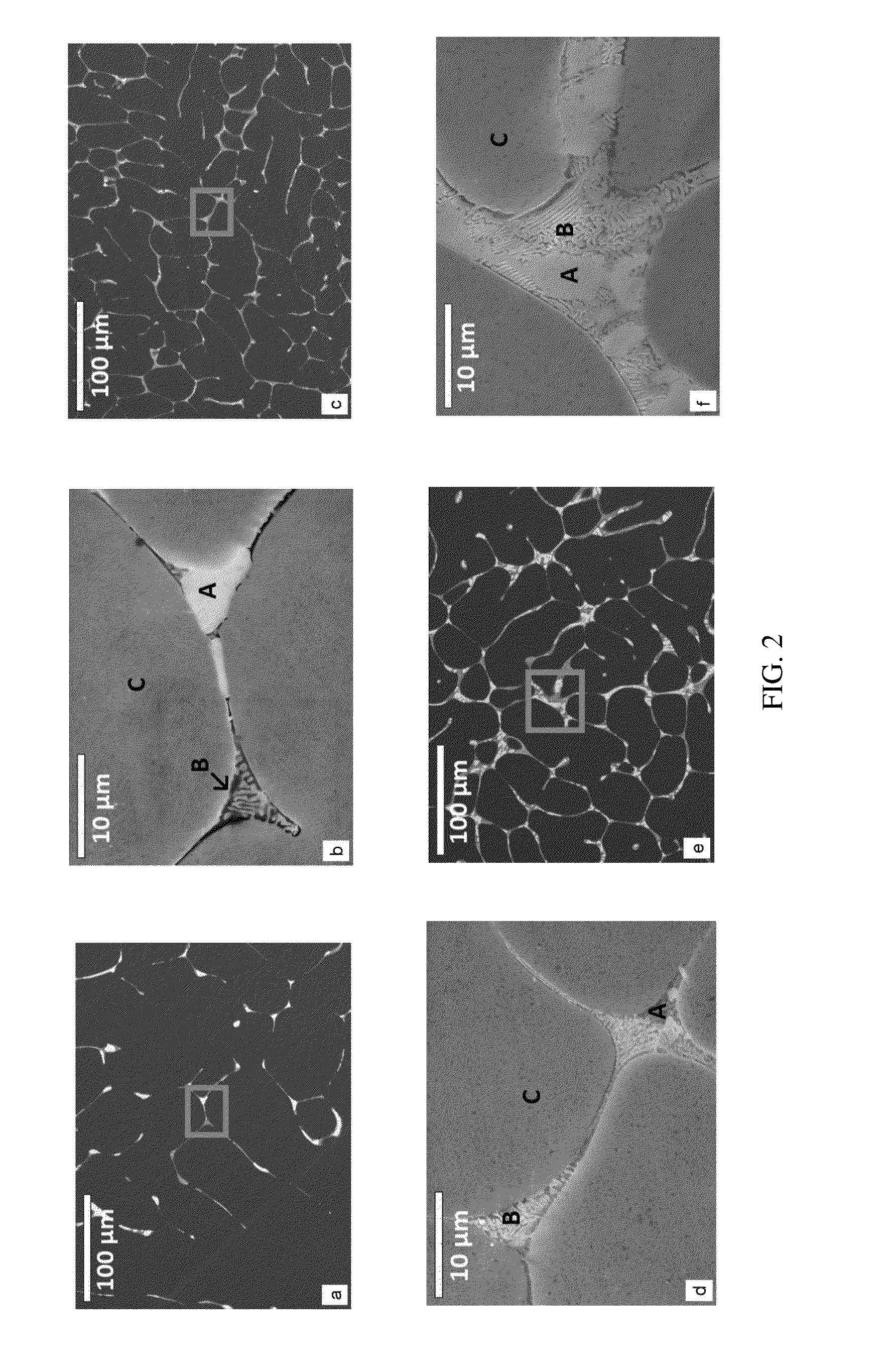Bioresorbable metal alloy and implants made of same
a bioresorbable metal alloy and metal alloy technology, applied in biocide, prosthesis, surgery, etc., can solve the problems of toxic alloying elements deformation in the human body, etc., and achieve excellent implant material, high corrosion rate, optimal mechanical function
- Summary
- Abstract
- Description
- Claims
- Application Information
AI Technical Summary
Benefits of technology
Problems solved by technology
Method used
Image
Examples
example 1
Alloy Preparation
[0026]In this study, five different Mg—Ca—Sr alloys with targeted compositions of Mg-0.5Ca-0.5Sr, Mg-1.0Ca-0.5Sr, Mg-1.0Ca-1.0Sr, Mg-1.0Ca-2.0Sr and Mg-7.0Ca-3.5Sr were prepared using high purity Mg chips (99.98%, Sigma-Aldrich, St. Louis, Mo.), Ca granules (99.5%, Alfa-Aesar, Ward Hill, Mass.) and Sr granules (99%, Sigma-Aldrich, St. Louis, Mo.). Melting of the alloys was carried out between 725-825° C. in high purity graphite crucibles. Each melt was held for approximately 40 min and stirred prior to pouring. The melt was then poured into high purity graphite moulds that were allowed to air-cool to room temperature. A protective argon atmosphere was maintained throughout the melting and casting process. The compositions of the as cast alloys were determined using inductively coupled plasma-atomic emission spectrometry (ICP-AES). The nominal and actual compositions of the investigated Mg alloys are listed in Table 2
example 2
Microstructural Characterization
[0027]For microscopic evaluation, the samples were ground with silicon carbide (SiC) emery papers to 4000 grit, and polished to 0.3 micron using a colloidal silica suspension. The polished samples were etched using acetic picral as an etchant. The microstructural analysis was performed using light optic microscopy (LOM, Olympus PME3) and scanning electron microscopy (SEM, JEOL JSM 6400). Energy-dispersive X-ray spectroscopy (EDS, JEOL JSM 6400) and XRD (Phillips APD 3720) was employed to identify the different phases present in the alloys and the corroded surfaces.
example 3
Immersion Tests
[0028]The samples were ground to 320 grit using SiC emery paper and then cleaned with ethanol. The immersion test was carried out at 37° C. in Hanks balanced salt solution containing 0.185 g / l CaCl2.2H2O, 0.40 g / l KCl, 0.06 g / l KH2PO4, 0.10 g / l MgCl2.6H2O, 0.10 g / l MgSO4.7H2O, 8.00 g / l NaCl, 0.35 g / l NaHCO3, 0.48 g / l Na2HPO4, 1.0 g / l D-Glucose (Thermo Scientific Inc., Waltham, Mass.). The ratio of Hanks solution to the surface area of the samples was kept approximately 150. The high value was chosen to minimize the change in pH value during the experiment. The hydrogen evolution was measured by placing the samples at the bottom of a beaker with a funnel and a measuring cylinder placed on top of the beaker to collect and measure the volume of hydrogen gas evolved. 13 The gas volume was measured every 24 h up to 8 days. The tests were performed in triplicates and the average of the data is reported.
PUM
| Property | Measurement | Unit |
|---|---|---|
| length | aaaaa | aaaaa |
| diameter | aaaaa | aaaaa |
| pore size | aaaaa | aaaaa |
Abstract
Description
Claims
Application Information
 Login to View More
Login to View More - R&D
- Intellectual Property
- Life Sciences
- Materials
- Tech Scout
- Unparalleled Data Quality
- Higher Quality Content
- 60% Fewer Hallucinations
Browse by: Latest US Patents, China's latest patents, Technical Efficacy Thesaurus, Application Domain, Technology Topic, Popular Technical Reports.
© 2025 PatSnap. All rights reserved.Legal|Privacy policy|Modern Slavery Act Transparency Statement|Sitemap|About US| Contact US: help@patsnap.com



